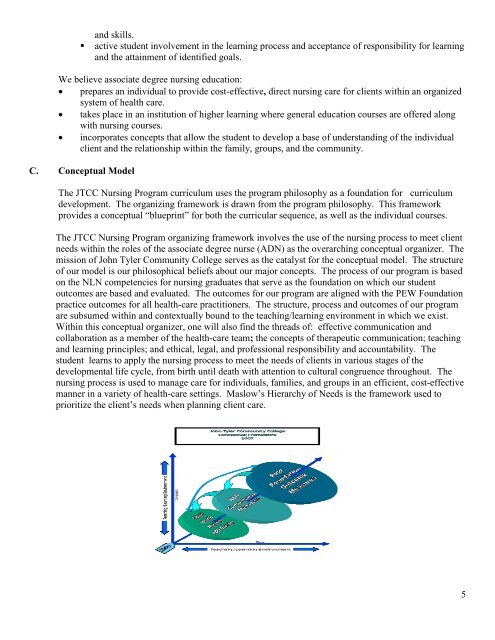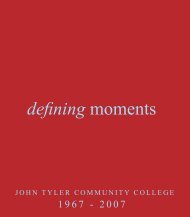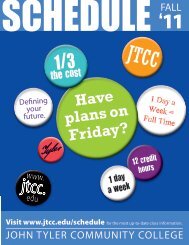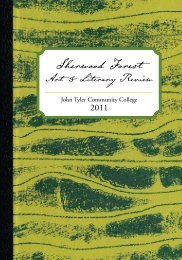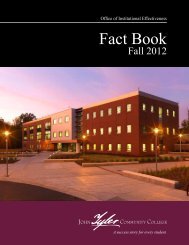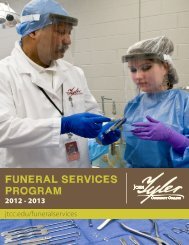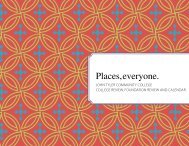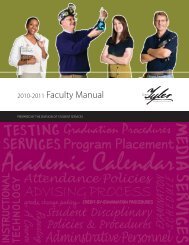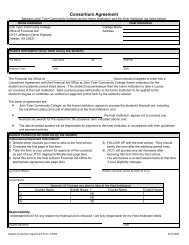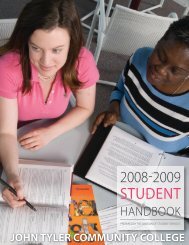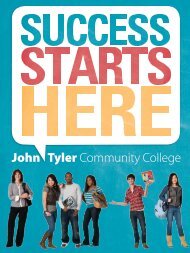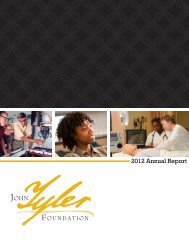Nursing Student Handbook - John Tyler Community College
Nursing Student Handbook - John Tyler Community College
Nursing Student Handbook - John Tyler Community College
You also want an ePaper? Increase the reach of your titles
YUMPU automatically turns print PDFs into web optimized ePapers that Google loves.
and skills.<br />
• active student involvement in the learning process and acceptance of responsibility for learning<br />
and the attainment of identified goals.<br />
We believe associate degree nursing education:<br />
prepares an individual to provide cost-effective, direct nursing care for clients within an organized<br />
system of health care.<br />
takes place in an institution of higher learning where general education courses are offered along<br />
with nursing courses.<br />
incorporates concepts that allow the student to develop a base of understanding of the individual<br />
client and the relationship within the family, groups, and the community.<br />
C. Conceptual Model<br />
The JTCC <strong>Nursing</strong> Program curriculum uses the program philosophy as a foundation for curriculum<br />
development. The organizing framework is drawn from the program philosophy. This framework<br />
provides a conceptual “blueprint” for both the curricular sequence, as well as the individual courses.<br />
The JTCC <strong>Nursing</strong> Program organizing framework involves the use of the nursing process to meet client<br />
needs within the roles of the associate degree nurse (ADN) as the overarching conceptual organizer. The<br />
mission of <strong>John</strong> <strong>Tyler</strong> <strong>Community</strong> <strong>College</strong> serves as the catalyst for the conceptual model. The structure<br />
of our model is our philosophical beliefs about our major concepts. The process of our program is based<br />
on the NLN competencies for nursing graduates that serve as the foundation on which our student<br />
outcomes are based and evaluated. The outcomes for our program are aligned with the PEW Foundation<br />
practice outcomes for all health-care practitioners. The structure, process and outcomes of our program<br />
are subsumed within and contextually bound to the teaching/learning environment in which we exist.<br />
Within this conceptual organizer, one will also find the threads of: effective communication and<br />
collaboration as a member of the health-care team; the concepts of therapeutic communication; teaching<br />
and learning principles; and ethical, legal, and professional responsibility and accountability. The<br />
student learns to apply the nursing process to meet the needs of clients in various stages of the<br />
developmental life cycle, from birth until death with attention to cultural congruence throughout. The<br />
nursing process is used to manage care for individuals, families, and groups in an efficient, cost-effective<br />
manner in a variety of health-care settings. Maslow’s Hierarchy of Needs is the framework used to<br />
prioritize the client’s needs when planning client care.<br />
5


